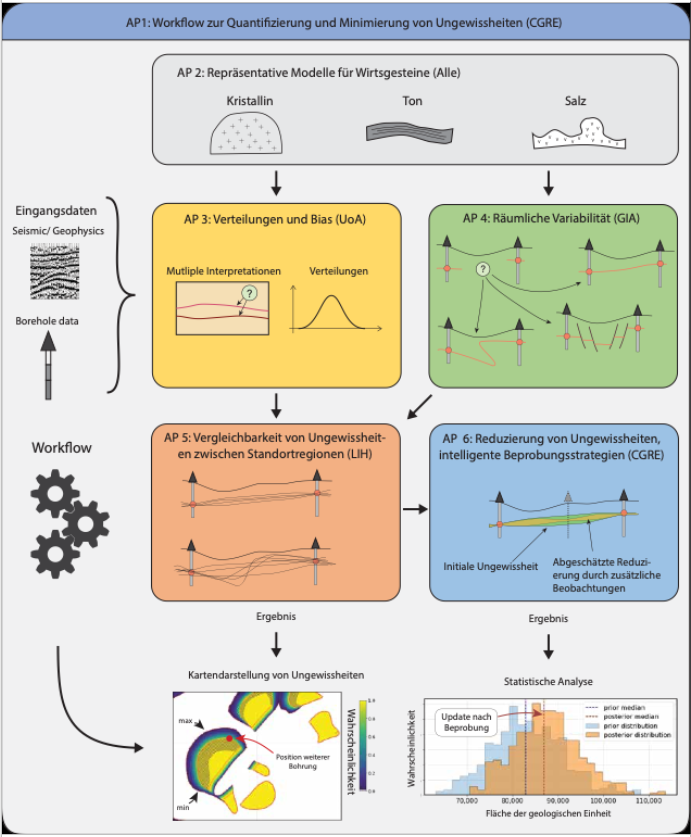¶ Building blocks for quantifying uncertainties in geological models
According to the Site Selection Act (StandAG), the analysis of uncertainties in the geological description of areas is an important aspect of the search and selection of a site for a repository for high-level radioactive waste. Due to the complexity of the geology and an often quantitatively and qualitatively heterogeneous data situation - geological-geometric prognoses exhibit various uncertainties. These can be roughly divided into measurement uncertainties and geometric uncertainties. The latter also include uncertainties based on the experience of the interpreting geologist.
¶ Project Objectives
The objective of GeoBlocks project is to scientifically illuminate uncertainties in geological models from different angles and to derive concrete methods that allow for the quantification and communication of geological uncertainties. The following scientific goals are pursued:
- Creation of a workflow for geological modelling with a quantification of uncertainties
- Systematic analysis of uncertainties in the geological and geophysical input data used
- Quantitative description of the spatial variability of host rocks
- Development of methods for the comparability of regions with different data situation
- Approaches for the reduction of uncertainties through intelligent sampling strategies
These aspects will be tested on representative geological models of the three host rocks (rock salt, clay rock and crystalline rock) and integrated into the developed workflow. By means of a probabilistic approach, further statements on characterisability and predictability will be possible.
The comprehensive goal of the project is to enable a quantification of uncertainties of the geological models in all further steps of the site search, from the analysis of regions to the characterisation of sites and for further use in simulations for safety analysis, as well as for communication with decision makers and the public.
¶ Methodology
In accordance with the aforementioned scientific goals, the project is divided into the following sub-projects based on the current state of research:

|
|
Since the StandAG stipulates that the geological barrier is the main protection against the release of radionuclides into the biosphere, geological models are decisive for all safety investigations. For all necessary modelling, the geological models, including uncertainty considerations, will form the geometric as well as parametric basis, i.e. they are the starting point. For this reason, it is essential to quantify the distribution of rocks and their properties together with the uncertainties, which is the goal of GeoBlocks.
¶ Current Activities
The project is currently building a catalogue of most-expected geological models for site storage, and researching and developing interpolation and uncertainty quantification methods.
¶ Project Publications
- Yang J., Colombo C., Carl F., Gonzalez de Lucio G. de los A., Achtziger P., Kukla P. and Wellmann F., “Intelligent interpolation strategies in geological modelling for safe storage sites: comparison and uncertainty approach”, RING Meeting, 2023. Poster.
- Carl F., Gonzalez de Lucio G. de los A., Yang J., Achtziger P., Kukla P. A., Bense F. and Wellmann F., "Host rock analysis for the German nuclear waste disposal site-selection: review of subsurface geometries and input data for geological modelling", RING Meeting, 2023. Poster.
- Yang J., Colombo C., Carl F., Gonzalez de Lucio G. de los A., Achtziger P., Kukla P. and Wellmann F., “GeoBlocks: Building Blocks for Model Creation and Uncertainty Analysis”, GeoTag, RWTH, 2023. Poster.
- Colombo C. and Wellmann F., “Implicit Modelling with GemPy and Spatial Uncertainty Reduction of Potential Nuclear Waste Storage Sites”, International Association for Mathematical Geosciences (IAMG), 2023. Oral presentation.